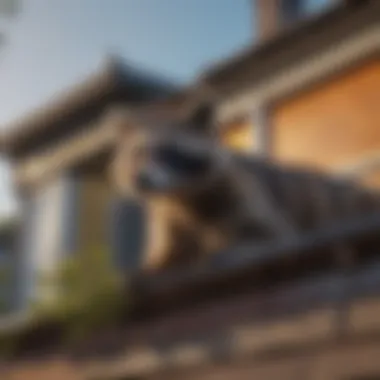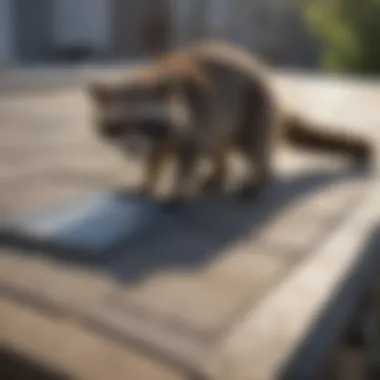Effective Methods for Raccoon Removal from Your Roof


Preventive Pest Control Strategies
When it comes to safeguarding your home from unwanted pests like raccoons, implementing preventive pest control strategies is crucial. Starting with protecting your house exterior, you should focus on sealing any cracks that could serve as entry points for raccoons. Regularly clearing debris from around your property is essential to eliminate potential hiding spots for pests. Additionally, taking measures to prevent pests from entering your home through small openings or gaps will help reduce the risk of raccoon infestations.
Maintaining your yard is another key aspect of pest control. By following essential yard care routines such as mowing the lawn, trimming bushes, and removing standing water, you can create an environment that is less appealing to raccoons. Implementing methods to keep your yard pest-free, such as using pest-resistant plants and removing fallen fruits or nuts, will further deter raccoons from making themselves at home on your roof.
Indoor cleanliness plays a significant role in preventing pest issues. Expert cleaning tips and techniques, such as regularly sweeping, dusting, and vacuuming, can help eliminate food sources and nesting sites for raccoons. Maintaining a pest-resistant indoor environment through proper storage of food, sealing trash cans tightly, and fixing leaky plumbing will act as additional deterrents against raccoon invasions.
Effective garbage disposal is also essential in pest control efforts. Implementing efficient waste disposal methods, such as using secure bins with locking lids, will prevent raccoons from being attracted to your property by the scent of food. Emphasizing the importance of proper garbage disposal to household members and ensuring that all waste is properly disposed of will further discourage raccoons from choosing your roof as their habitat.
In addition to these fundamental preventive measures, exploring innovative ways to safeguard your home, such as installing motion-activated lights or sound devices that deter raccoons, can provide an extra layer of protection against these persistent pests.
Understanding Raccoon Behavior
Understanding raccoon behavior is a crucial aspect when it comes to effectively removing raccoons from your roof. By delving into the various behaviors and habits of raccoons, homeowners can better equip themselves to tackle raccoon infestations in a strategic manner. This section will provide insights into nocturnal behavior patterns, nesting preferences, and food sources of raccoons, shedding light on their motives and activities that lead them to invade residential spaces.
Identifying Raccoon Entry Points
Inspecting Roof Openings
Inspecting roof openings is a fundamental step in the process of identifying potential entry points for raccoons. This task involves a meticulous examination of all areas on the roof where raccoons may gain access, such as gaps, vents, or loose shingles. By inspecting these openings, homeowners can pinpoint vulnerable areas that raccoons exploit to enter the attic or roof space. This method is beneficial as it helps in fortifying weak spots and implementing preventive measures efficiently.
Checking Soffit and Fascia for Damage
Checking soffit and fascia for damage is another crucial aspect of identifying raccoon entry points. Raccoons often target these areas to create openings or enlarge existing ones for easier entry. By paying close attention to the condition of soffits and fascias, homeowners can identify signs of tampering or damage caused by raccoons. This method proves to be popular due to its effectiveness in uncovering accessible points that raccoons use to infiltrate homes.
Examining Chimneys and Vents
Examining chimneys and vents plays a vital role in the process of identifying potential raccoon entry points. Chimneys and vents provide direct access to the interior of a home, making them attractive entry points for raccoons seeking shelter. By thoroughly assessing the condition of chimneys and vents, homeowners can detect any signs of raccoon activity or damage that indicate intrusion. This method's advantage lies in its ability to target specific areas where raccoons commonly enter, allowing for targeted reinforcement and blocking measures.


Recognizing Signs of Raccoon Infestation
Scattered Debris and Droppings
Recognizing scattered debris and droppings is a key element in identifying a raccoon infestation. Raccoons often leave a trail of debris and droppings in their path as they move around a property. These visible signs serve as indicators of raccoon presence and activity, alerting homeowners to the need for immediate action. While beneficial for identifying infestations, the presence of scattered debris and droppings signifies an ongoing problem that requires prompt intervention.
Unusual Noises at Night
Unusual noises at night are another telltale sign of a raccoon infestation. Raccoons are primarily nocturnal creatures, so any disturbances or racket during nighttime could signal their presence on the roof or in the attic. Homeowners should pay attention to these noises, as they indicate potential raccoon activity that needs to be addressed swiftly. While helpful in alerting residents of infestations, these noises can be a nuisance and disrupt peaceful living conditions.
Visible Paw Prints
Recognizing visible paw prints is a tangible sign of raccoon presence that aids in identifying an infestation. Raccoons often leave distinct paw prints in mud, snow, or dusty surfaces, providing concrete evidence of their intrusion. Homeowners can use these prints to track raccoon movement patterns and ascertain the extent of infestation. While beneficial for tracking raccoon activity, visible paw prints serve as a visual reminder of the threat raccoons pose to property and safety.
Understanding Raccoon Habits
No
Safely Removing Raccoons
When it comes to the intricate task of dealing with raccoons on your roof, the aspect of safely removing them is of paramount importance. This section delves into the crucial steps and considerations that one must undertake to address this issue effectively. By incorporating humane tactics and methods, you not only safeguard your property from potential harm but also ensure a secure environment for both yourself and the wildlife involved. Understanding the significance of safely removing raccoons is key to mitigating any potential risks and damages.
Implementing Humane Removal Techniques
Using Live Traps
One of the most humane methods of removing raccoons from your roof is by utilizing live traps. These traps are specifically designed to capture the raccoons without causing them any harm, allowing for their safe removal and release back into the wild. The key characteristic of using live traps lies in its ability to address the nuisance without resorting to lethal measures. This method not only ensures the well-being of the raccoons but also aligns with ethical wildlife control practices. However, it is essential to remember that releasing the captured raccoons should be done far away from your property to prevent their return.
Seeking Professional Help


Engaging professional help when dealing with raccoons on your roof can significantly contribute to the overall efficiency and success of the removal process. Wildlife control experts have the expertise and experience to handle such situations adeptly, ensuring a safe and effective removal without causing harm to the animals. The key characteristic of seeking professional help lies in their ability to assess the situation accurately and implement appropriate measures tailored to your specific needs. While this may incur a cost, the peace of mind and assurance of a job well done make it a beneficial choice for this scenario.
Avoiding Lethal Measures
In a world where quick fixes often involve lethal methods, avoiding such measures when removing raccoons from your roof is crucial. Lethal measures not only contradict humane practices but also pose ethical and legal concerns. By steering clear of lethal measures, you prioritize the well-being of the raccoons and uphold a sense of respect for wildlife. The unique feature of avoiding lethal measures in this context lies in promoting coexistence and harmony between humans and wildlife, fostering a more sustainable approach to conflict resolution.
Securing Your Roof After Removal
After successfully removing the raccoons from your roof, securing it to prevent future intrusions is paramount. This section elaborates on the necessary steps to take post-removal to ensure your property remains raccoon-free.
Repairing Entry Points
One essential aspect of securing your roof post-removal is repairing any entry points that the raccoons may have used to access your property. By addressing and reinforcing these vulnerable points, you not only prevent re-entry by raccoons but also fortify your property against other potential pests. The key characteristic of repairing entry points lies in its proactive approach to pest control, eliminating possible entryways for raccoons and other wildlife. While the task may require time and effort, the long-term benefits far outweigh the initial investment.
Installing Barriers and Deterrents
Another effective method of securing your roof involves installing barriers and deterrents to dissuade raccoons from attempting to re-enter your property. Barriers such as fencing or mesh systems can physically block access to vulnerable areas, while deterrents like predator urine or motion-activated devices can discourage raccoons from returning. The unique feature of installing barriers and deterrents lies in creating a hostile environment for raccoons, making your property less attractive to them. While these measures may require maintenance and upkeep, the peace of mind they provide is invaluable.
Regular Inspection and Maintenance
Maintaining a routine of regular inspection and maintenance is key to ensuring the continued security of your roof against raccoon intrusions. By staying vigilant and addressing any potential vulnerabilities promptly, you minimize the risk of future infestations and preserve the integrity of your property. The key characteristic of regular inspection and maintenance lies in its preventative nature, allowing you to nip any issues in the bud before they escalate. While this may entail periodic checks and repairs, the peace of mind and security it offers make it a worthwhile endeavor.
Preventing Future Raccoon Intrusions
Preventing future raccoon intrusions is a critical aspect discussed in this article to protect your property from potential damage and maintain a secure environment. By implementing proactive strategies, homeowners can effectively deter raccoons from accessing their roofs and nesting on their premises. This section focuses on various elements, benefits, and considerations regarding preventing future raccoon intrusions to help readers safeguard their homes.
Eliminating Attractive Food Sources
Proper Garbage Management


Proper garbage management plays a pivotal role in deterring raccoons from frequenting your property. By ensuring that garbage bins are securely sealed and not easily accessible to these nocturnal animals, homeowners can significantly reduce the likelihood of attracting raccoons to their roofs. Proper garbage management also involves regular disposal of waste to eliminate any food sources that might entice raccoons. While this method may seem simple, its effectiveness in minimizing raccoon intrusions cannot be overstated, making it a popular and practical choice for homeowners looking to keep raccoons at bay.
Securing Pet Food
Securing pet food is another essential aspect of preventing raccoon intrusions. Leaving pet food outdoors can inadvertently attract raccoons searching for easy meals. To mitigate this risk, pet owners should feed their pets indoors and store pet food in sealable containers. Securing pet food not only discourages raccoons from approaching but also prevents potential conflicts between pets and wildlife. This method offers a straightforward yet efficient approach to reducing the chances of raccoon visits, enhancing overall household safety.
Trimming Overhanging Trees
Trimming overhanging trees is a strategic step in limiting raccoon access to roofs and attics. Raccoons are adept climbers and can use tree branches to gain entry to higher structures. By keeping trees near the house trimmed and removing branches that could serve as pathways, homeowners can create a physical barrier that deters raccoons from reaching their roofs. This method is a beneficial choice for preventing raccoon intrusions as it not only limits their access but also contributes to enhancing the aesthetics and safety of the property. While trimming overhanging trees requires regular maintenance, its advantages in deterring raccoons outweigh the effort involved for homeowners.
Utilizing Motion-Activated Devices
Ultrasonic Repellers
Ultrasonic repellers are electronic devices designed to emit high-frequency sound waves that are unsettling to raccoons. These repellers effectively deter raccoons from invading your property by producing noises that mimic natural threats, prompting the animals to stay away. The key characteristic of ultrasonic repellers lies in their non-invasive approach, as they operate without physical contact or harm to the raccoons themselves. Homeowners find ultrasonic repellers beneficial for their ease of use and ability to offer continuous protection against raccoon intrusions.
Light and Sound Deterrents
Light and sound deterrents are another effective method for deterring raccoons from approaching your property. By utilizing flashing lights and loud sounds, these deterrents create a hostile environment for raccoons, dissuading them from staying on or near your premises. The key characteristic of light and sound deterrents is their ability to trigger a raccoon's flight response, compelling them to seek safer locations away from the perceived danger. This popular choice for raccoon control provides homeowners with a non-physical means of protecting their homes, promoting a safe coexistence with wildlife.
Sprinkler Systems
Sprinkler systems equipped with motion sensors offer a dynamic defense against raccoon intrusions. When motion is detected, these systems activate sprinklers that release a sudden burst of water, startling and deterring raccoons from lingering in your yard or near your home. The unique feature of sprinkler systems lies in their immediate response to motion, effectively interrupting raccoons' activities and encouraging them to retreat. While offering an environmentally friendly and harmless method of raccoon deterrence, sprinkler systems are favored for their efficient and automated approach in maintaining a raccoon-free environment.
Seeking Professional Consultation
Roof Inspection Services
Roof inspection services provide homeowners with a comprehensive assessment of their property's vulnerabilities to raccoon intrusions. Professional inspectors evaluate roof structures, identify potential entry points, and recommend necessary repairs or modifications to fortify the property against wildlife access. The key characteristic of roof inspection services is their ability to offer personalized solutions tailored to address specific raccoon threats, ensuring long-term effectiveness in deterring these animals. While enlisting roof inspection services may incur some costs, the advantages of proactive maintenance and prevention far outweigh the potential risks of raccoon infestations.
Wildlife Control Experts
Wildlife control experts are trained professionals skilled in handling raccoon infestations and implementing effective removal strategies. By engaging the services of wildlife control experts, homeowners can benefit from expert knowledge and experience in dealing with raccoon behavior and habits. The unique feature of wildlife control experts is their proficiency in utilizing humane techniques to remove raccoons safely and relocate them to suitable habitats. While seeking assistance from wildlife control experts may be an investment, the peace of mind and expert guidance they provide in managing raccoon intrusions are invaluable for homeowners seeking long-term solutions.
Long-Term Prevention Strategies
Implementing long-term prevention strategies is essential for maintaining a raccoon-free environment. By integrating sustainable practices such as habitat modification, exclusion methods, and ongoing monitoring, homeowners can proactively deter raccoons from accessing their properties. The key characteristic of long-term prevention strategies is their emphasis on addressing root causes of raccoon intrusions rather than transient solutions. While these strategies may require ongoing effort and commitment, their advantages in ensuring continual protection and minimizing risks associated with raccoon infestations make them an indispensable choice for homeowners looking to safeguard their homes effectively.



